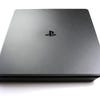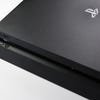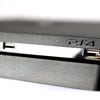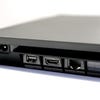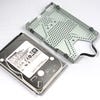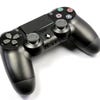Digital Foundry: Hands-on with the CUH-2000 PS4 Slim
First impressions: better than the existing PS4 in almost every way.
Sony's PlayStation 4 'slim' revision - codenamed CUH-2000 - follows in a fine tradition of excellent quality second-gen Sony hardware. The new console is significantly more power efficient, it generates less heat and it is palpably quieter. And as for its divisive looks? Let's just say that the photos seen thus far do not do this product justice. With one notable exception, there's no sense that Sony was fighting to bring this product in at a specific budget. You still feel like you're getting your money's worth: it looks and feels solid, and build quality is on par with the existing models.
Let's begin by talking about the aesthetics. The questionable quality of the product photography on its packaging - the first image we saw during the infamous leak - doesn't do the hardware any favours. This is not another PlayStation 3 'Super Slim' - the CUH-2000's matte plastics are a match for the C-Chassis PS4, the fit and finish is just as good and the overall design is full of nice touches. The underside's 'feet' - comprising of PlayStation symbols - have been well-documented, and we can confirm that the unit doesn't wobble as some have speculated.
In addition to their appearance on the bottom of the unit, the PlayStation symbols are also embossed into one recessed side of the chassis, while on the other side, we see HDMI, DTS, Dolby and Blu-ray logos - telling us that, yes, this is still a standard 1080p HD console with no 4K pretensions. The PS4 Slim offers few core functionality upgrades and 4K streaming functionality is limited to the more expensive Pro model.
There are some other nice touches too - the new model CUH-ZCT2E Dual Shock 4 receives a minor makeover: the analogue sticks, triggers and d-pad have a grey colour that contrasts nicely with the black finish of the rest of the pad. Meanwhile, the touchpad has a small horizontal slit running across the top, allowing the light from the RGB LED to shine though - so you don't need to tilt the pad around to see its current colour scheme, just a quick glance down gets the job done.
In terms of additional functionality, you can now choose between Bluetooth and USB connections when the joypad is connected via cable to the PS4, so in theory you can claw back a few milliseconds of latency using a fully wired connection. In practise, it's going to be hard to tell any difference. This feature is a part of the new Dual Shock 4, and not related to the CUH-2000 console. Hook up the pad to an older PS4 and the same option remains.
- Pre-order the PS4 Slim 500GB from Amazon.
- Pre-order the PS4 Slim 1TB from Amazon.
Cutbacks, oddities and missed opportunities? Well, we're a touch disappointed that there are still just two USB 3.0 ports on the front of the unit, and it's curious to see the somewhat strange spacing between them (maybe this will make sense once the PlayStation VR external processor sits alongside it?). Secondly, yes, the Toslink SPDIF digital output on the back of the console has indeed been removed. Check under the Audio Output Settings area of the PS4 front-end and not surprisingly, all mention of optical output is gone.
In terms of the system software itself, the PlayStation 4 CUH-2000 updates out of the box to the latest Sony firmware, and as you might expect, it looks and acts exactly like the standard PlayStation 4 - with one exception. Under Network Settings, the new unit now specifies the speed of the network you are connected to - something that doesn't happen on original hardware. This is the one area of the PS4 spec that does see an actual upgrade - all flavours of 5GHz WiFi are now supported.
The hard drive situation sees the new PS4 Slim sit nicely alongside the existing models - meaning that upgrading the HDD is still an option - though it does look as though Sony has switched suppliers. The unit we looked at features a 500GB Toshiba MQ01ABD050 2.5-inch HDD, confirmed via a quick search as a standard 5400rpm drive. However, the means by which you gain access has changed. An L-shaped piece of plastic detaches from the side of the PS4's casing, and from there, the familiar PS symbol-embossed screw is removed in order to take out the caddy. The caddy itself features a metallic ribbon loop to pull on in order to facilitate easy removal of the drive - a nice touch.
So far, so good then. What we're looking at so far is a unit that's essentially identical in terms of function to the existing models, with some interesting design touches - and with 5GHz WiFi, a feature we've been looking out for on PlayStation 4 hardware for quite some time. The lack of the optical output is a bit of a pain for those hoping to attach older AV equipment, but perhaps more so for owners of gaming headsets. Sony's existing - and rather excellent - headset uses a USB dongle, so that works just fine (something worth bearing in mind for PlayStation VR functionality). The looks of the new unit are clearly a point for discussion, but from my perspective, no more so than the controversy raised by the original unit's looks when it was first revealed.
In other respects, the new PlayStation 4 Slim is a clear upgrade over the existing model, in three particularly crowd-pleasing ways. There are substantial power efficiency wins here, effectively confirming that the PS4 Slim is indeed using FinFET fabrication technology for its processor (a 16nm design manufactured by existing PS4/Xbox One chipmaker TSMC is almost certain). In turn, this means a cooler unit, and yes, it is much quieter overall. We are going to stack up the Slim against both launch and C-Chassis units here, but we should point out that conditions for this hands-on were very different in terms of the test environment. However, the trends from the results are obvious - and by and large, it's all good news.
We re-ran a sub-set of the tests we carried out when reviewing the CUH-1200. A 4x4 Rocket League 4x4 match creates some unholy noise on the launch unit, and while the C-Chassis machine saw a marked improvement, the Slim takes it to another level: we saw a 52 per cent reduction in power draw compared to the launch model and a 37 per cent drop compared to the CUH-1200 (note: we re-ran the CUH-1000/1200 tests after producing the video above and noted a small reduction in consumption on older hardware, reflected in the results below). Noise is massively reduced too - eight decibels quieter than the C-Chassis PS4 with a 20dB reduction (!) compared to the initial launch machine. The bottom line though - the PS4 Slim ran Rocket League with barely a whisper compared to some full throttle fan action on older PlayStation hardware.
There are limits to the discrete nature of the PlayStation 4 Slim, however. The Blu-ray drive remains rather loud when installing a game, and while the thermal solution is obviously quieter, there are situations where the system's fans really start to spin up. This is clearly the case with 'fan favourite' Assassin's Creed Unity. Power consumption drops by 44 per cent compared to the launch model and 23 per cent compared to the CUH-1200, but even running the game just on the title screen, with the disc active, produced an identical noise reading to our C-Chassis test results.
| PlayStation 4 Max Power/Noise (Watts/Decibels) | CUH-1000 Peak Power (Watts) | CUH-1200 Peak Power (Watts) | CUH-2000 Peak Power (Watts) | CUH-1000 Noise (Decibels) | CUH-1200 Noise (Decibels) | CUH-2000 Noise (Decibels) |
|---|---|---|---|---|---|---|
| PS4 Front-End (Online) | 80.1 | 65.6 | 47.0 | 44.0 | 42.2 | 41.0 |
| Rocket League 4v4 on Mannsfield | 130 | 100 | 63.0 | 63.7 | 51.2 | 43.2 |
| AC Unity Title Screen (disc spinning) | 130 | 112 | 86 | 64.5 | 55.2 | 55.0 |
We should stress once again that final numbers on this - plus any differences in game performance (we are not expecting any) will have to wait until a retail unit sits in the Digital Foundry office. Right now, what we have is a snapshot of CUH-2000 performance that tells us a few things - first of all, the chassis revision is based around a die-shrunk processor (not all PS3 form-factor revisions were) and there are clear power savings and reduced noise. After the Assassin's Creed Unity title screen stress test, we tested the temperature of the shell and that this maxed out at 38 degrees Celsius - a good six degrees lower than the launch unit in a similar test, and seven degrees lower than the CUH-1200 C-Chassis model. Again, final numbers will need to wait, but it's safe to assume that this new machine offers several clear advantages over the existing model - though unfortunately, a quieter BD drive doesn't seem to be part of the package.
In common with many, I was initially rather let down by the appearance of the new machine based on the leak photos, thinking that it looked like a squashed down and rounded off version of the original unit. However, first impressions 'in the flesh' are much more positive and once the additional benefits offered by the unit are factored in, the new PS4 Slim looks like a rather impressive offering overall. And it's small. Very small. It measures around 26.5cm x 26.5cm x 3.8cm - up against a 27.5cm x 30cm x 5.3cm launch unit. The measurements here suggest that just like Xbox One S, the PlayStation 4 Slim model sees around a 40 per cent reduction in overall volume.
Overall, we've only had a very short amount of time with the revised PlayStation 4 so far and we're eager to hammer down the results once we have a system in the office, but the outlook is very promising. The console is smaller and more discrete, but this hasn't resulted in any kind of noticeable compromise to system performance. The key litmus test is this: given the choice between a brand new PS4 Slim and the existing CUH-1200 model, which one would I pick? Well, based on the couple of hours spent with the new hardware, it's a no-brainer - the new PS4 is a winner. Fundamentally, it addresses one of the weakest points of the current generation PlayStation 4 - the noise level: it appears to be significantly quieter in many scenarios. In fact, in the tests we ran using digital content (ie no BD drive noise), it's up there with the original Xbox One and marginally quieter than the Xbox One S. We'll update with more metrics once we have the hardware in hand, but right now, this tidy little unit looks like a really impressive revision.



